List of Authors
>>About this blog
Recent blog post
|
[Nojinya]
January 10, 2016 14:00
When I go  to the ward office after having an errand at the to the ward office after having an errand at the  end of the New Year's holiday, there is a prize-winning work of the "Chuo-ku Sightseeing Photo end of the New Year's holiday, there is a prize-winning work of the "Chuo-ku Sightseeing Photo  Contest" on the right side of the lobby on the first floor. As already introduced by the correspondent fireworks of Sumida (/archive/2016/01/post-3012.html), there were many very wonderful works, but behind the exhibition, the sister city of Chuo-ku There is a permanent exhibition about Suzaland. Contest" on the right side of the lobby on the first floor. As already introduced by the correspondent fireworks of Sumida (/archive/2016/01/post-3012.html), there were many very wonderful works, but behind the exhibition, the sister city of Chuo-ku There is a permanent exhibition about Suzaland. 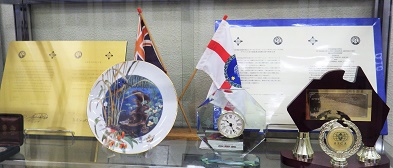 [Documents related to sister city agreement with Southernland indicated in permanent exhibition on the 1st floor lobby of Chuo-ku government office] [Documents related to sister city agreement with Southernland indicated in permanent exhibition on the 1st floor lobby of Chuo-ku government office]
Even if you say Sutherland Shire, it may not come. This is the local government of Australia. The first thing that comes to mind when it comes to Australia is a big city such as Sydney, Melbourne and Brisbane, or a resort area such as Cairns and Gold Coast, Sutherland is one of the 38 wards (special wards with autonomy) that make up the city of Sydney, and is located in New South Wales (N). Exchanges have been promoted with Chuo-ku since 1991.
*Note: Shire is almost the same concept as Borough in the UK, meaning the autonomous region (local government area) that constitutes a large city. In Chuo-ku, the city is used as a translation of Sutherland Shire, but our Chuo-ku is also a special ward (autonomous district = Chuo City in English), so here we will call it "Sazaland District (of Sydney City)". ).
The Sazaland District is located 35 kilometers south of central Sydney (CBD) across Sydney Kings Ford Smith International Airport  and Botany Bay. It is known as the birthplace of Australia, where the British naval officer James Cook landed in 1770 when he reached the East Coast of Australia on a voyage around the world. The ward is named by Forbes Sutherland, a Scottish seafarer of the Cook Expedition, who died of tuberculosis during his stay in the area. and Botany Bay. It is known as the birthplace of Australia, where the British naval officer James Cook landed in 1770 when he reached the East Coast of Australia on a voyage around the world. The ward is named by Forbes Sutherland, a Scottish seafarer of the Cook Expedition, who died of tuberculosis during his stay in the area.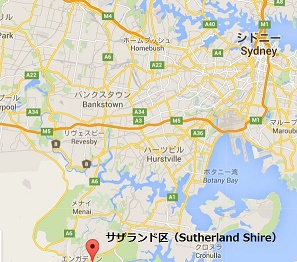
I sometimes go to Australia for work or personal trips, but unfortunately I haven't reached the Sazaland area yet, so I can't imagine what kind of place it is, but as far as I can see, it's like a place with a lot of nature, not far from the city center (Sydney CBD), and it's enviable to live.
In the past, Australia was not a very easy-to-access country because there were many air flights from Japan compared to Europe and the United States, but LCC jetstar Narita flights (Gold Coast, Cairns) have been fully established, and since December 11, ANA has also flew Haneda and Sydney direct flights. from Japan compared to Europe and the United States, but LCC jetstar Narita flights (Gold Coast, Cairns) have been fully established, and since December 11, ANA has also flew Haneda and Sydney direct flights.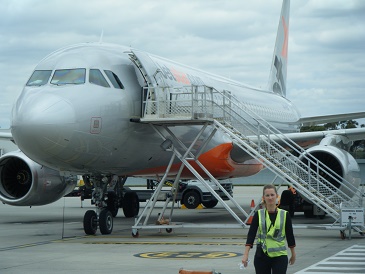
[Jetstar Airways parked at Melbourne Airport]
While thinking about such things, I missed Australian wine. 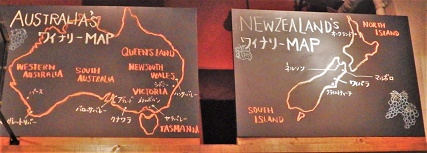 There are many Australian wine There are many Australian wine shops in Chuo-ku, but today I will go to "Wineya Ginza 1-chome" near the Chuo-ku Tourism Association. There is a flag of Australia at the entrance of the store, so you can see it right away. shops in Chuo-ku, but today I will go to "Wineya Ginza 1-chome" near the Chuo-ku Tourism Association. There is a flag of Australia at the entrance of the store, so you can see it right away.
When you enter the store, the inside of the store, which has a large space and a high ceiling, is full    of New Year's party customers. On the wall, there are objects decorated with wine bottles and explanations of wineries in Australia and New Zealand, so the mood is excited. of New Year's party customers. On the wall, there are objects decorated with wine bottles and explanations of wineries in Australia and New Zealand, so the mood is excited.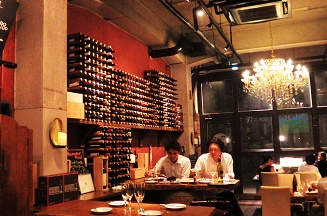
Also, on a large-screen TV, a video of the Rugby World Cup in Japan VS Samoa last October was played, and I feel like I'm in a bar in Melbourne. 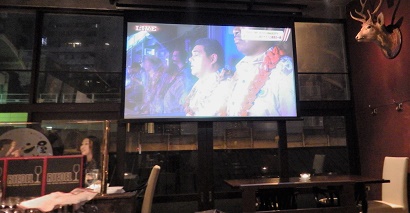 Mr. Hironaka, a floor staff member, decided to receive red wines from South Australia "Reschke Vitulus Cabernet Sauvignon" and "Mushroom Ahijo". Mr. Hironaka, a floor staff member, decided to receive red wines from South Australia "Reschke Vitulus Cabernet Sauvignon" and "Mushroom Ahijo". 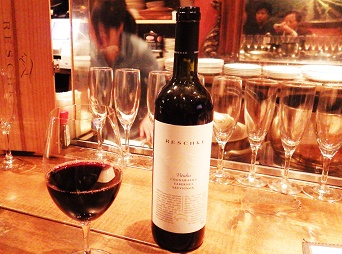 In this shop, not only Australia wine, but also the snacks are not only classic wine snacks such as cheese and olives, but also the mushroom Ahijo (pictured below) and seafood you received this time, and it has a taste that goes well with wine. In addition, Mr. Hironaka and other clerks are friendly and very pleasant in the Southern Hemisphere. In this shop, not only Australia wine, but also the snacks are not only classic wine snacks such as cheese and olives, but also the mushroom Ahijo (pictured below) and seafood you received this time, and it has a taste that goes well with wine. In addition, Mr. Hironaka and other clerks are friendly and very pleasant in the Southern Hemisphere.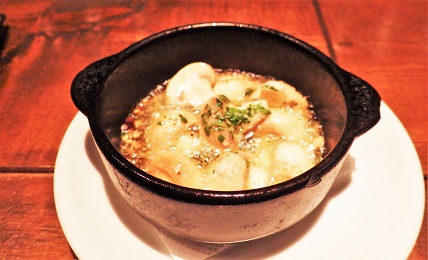
Soon, Australia Day (January 26), Australia's National Foundation Day. After eating in Ginza, if you don't have enough drinking, why don't you stop by once!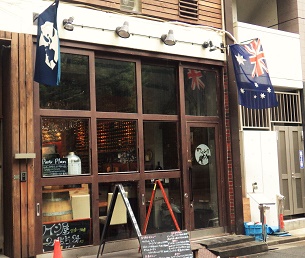
[Permanent exhibition of "Sister City Sazaland" in Chuo-ku government office]
Location 1-1-1 Tsukiji, Chuo-ku, 104-8404, Japan (Lobby on the 1st floor of the main building of Chuo-ku government office)
Viewing time: 8:30-17:00 (within office hours)
Access Edo Bus, Subway Yurakucho Line / Shintomicho Station, Hibiya Line Tsukiji Station, CCC  (Community Cycle) C01 Chuo-ku Government Office Port (Community Cycle) C01 Chuo-ku Government Office Port
[Wine shop Ginza 1-chome store]
Location 1F, The Associate Building, 1-27-10 Ginza, Chuo-ku, 104-0061, Japan
Phone: 03‐3535‐6567
Business hours From 18:00 to 25:00 (17:00 to 24:00 on weekends and holidays)
[Nojinya]
January 8, 2016 12:00
Holiday season during the year-end and New Year holidays. Due to the recent boom in Japan, friends often come from overseas. In the past, Ginza, Senso-ji Temple, and dinner were "Japanese food during the year-end and New Year holidays. Due to the recent boom in Japan, friends often come from overseas. In the past, Ginza, Senso-ji Temple, and dinner were "Japanese food ", but recently there have been a variety of requests for Tsukiji and traditional architecture. The other day, when I was having dinner in Ginza with a friend of France, I suddenly requested that I go to the "100 yen ", but recently there have been a variety of requests for Tsukiji and traditional architecture. The other day, when I was having dinner in Ginza with a friend of France, I suddenly requested that I go to the "100 yen  shop". shop".
"Is there a hundred yen  shop around here?" 。 shop around here?" 。
~~~ I was going to hold down some shops that seemed to be popular with foreigners, such as the Apple Store in Ginza, Yamada Denki in Yaesu, and Don Quijote in Ginza 8-chome, but it was a bit blind spot. ~~
"Hundred yen  shops are often located in Saitama, Chiba, or suburbs where bedroom towns are located, so they may not be in Chuo-ku?" shops are often located in Saitama, Chiba, or suburbs where bedroom towns are located, so they may not be in Chuo-ku?" 。 。
I don't want to go too far from this time because I already don't have much time in the evening and the trains are crowded. When I was searching on a mobile phone without hesitation, it was in Harumi (the only big 100 yen shop in the city was here). Immediately, from the bus stop along Harumi-dori St., take "Tokyo 05 " to Triton. It will arrive in just 10 minutes. " to Triton. It will arrive in just 10 minutes.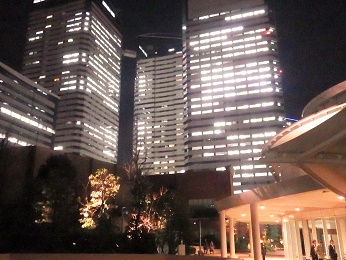
[Harumi Triton Square]
 It is a 100 yen shop in the city center, but it is quite large and there are plenty of items. My friend also mutters with a happy face It is a 100 yen shop in the city center, but it is quite large and there are plenty of items. My friend also mutters with a happy face saying "La caverne d'ali baba (Cave of Ali Baba)" saying "La caverne d'ali baba (Cave of Ali Baba)" and throws goods into the shopping basket more and more. I remember a French instructor at the NHK Radio Course told me that the 100 yen shop was popular with tourists visiting France as the "Cave of Ali Baba". and throws goods into the shopping basket more and more. I remember a French instructor at the NHK Radio Course told me that the 100 yen shop was popular with tourists visiting France as the "Cave of Ali Baba".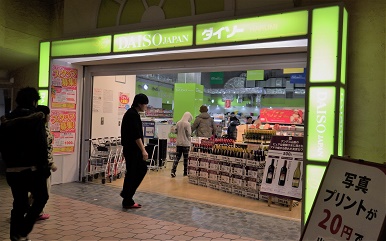
[Daiso Harumi Triton Store]
Did you stay for about an hour before the closing of the store? With a satisfactory  face, lower a large bag in both hands and come out. face, lower a large bag in both hands and come out.
"I bought it cheaply, but  it wouldn't be worth it if I got a taxi?" it wouldn't be worth it if I got a taxi?"
"No,  I don't have such a wonderful store in France! You may come all the way by plane I don't have such a wonderful store in France! You may come all the way by plane ." ."
。 。 。 The airplane is a bit over, but it seemed attractive that it was not easy to find in Western Europe and where you can buy a wide variety of goods cheaply. It seems that sightseeing in Japan is also changing rapidly. is a bit over, but it seemed attractive that it was not easy to find in Western Europe and where you can buy a wide variety of goods cheaply. It seems that sightseeing in Japan is also changing rapidly. 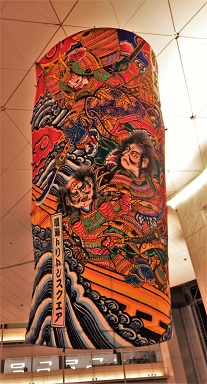 [Large kite in the Harumi Triton Square Grand Lobby] [Large kite in the Harumi Triton Square Grand Lobby]
[Daiso Harumi Triton Store]
Location 2nd floor of Triton Square, 1-8-16 Harumi, Chuo-ku, 104-0053, Japan
Phone: 03-6221-3048
Business hours 10:00~21:00
Access
<In front of Harumi Triton Square /  From Harumi 3-chome bus stop> From Harumi 3-chome bus stop>
‐ Tokyo Bus: Tokyo 03 (bound for Yotsuya Station via Ginza 4-chome), Tokyo 05 (bound for Tokyo Station Marunouchi South Exit via Ginza 4-chome), East 15 (bound for Tokyo Station Yaesu Exit via Shinkawa and Hatchobori)
- Harumi Liner: Yurakucho, Tokyo Station Yaesu North Exit, Nihonbashi Takashimaya area.
‐ Edo Bus South Circulation: To Kachidoki Station, Chuo-ku government office.
<Community Cycle (CC C)> : Cherry Blossom promenade (D03) near Port. C)> : Cherry Blossom promenade (D03) near Port.
[Nojinya]
January 5, 2016 16:00
 Today, I would like to take up "Suzuran Street" as a theme. When I wrote an article in the past, I mistakenly told me about this street ("Ginza Suzuran Street") (the part has already been modified). This time, I would like to dig deeper into this street so as not to make a mistake as a correspondent who correctly conveys sightseeing information in Chuo-ku in the future. Today, I would like to take up "Suzuran Street" as a theme. When I wrote an article in the past, I mistakenly told me about this street ("Ginza Suzuran Street") (the part has already been modified). This time, I would like to dig deeper into this street so as not to make a mistake as a correspondent who correctly conveys sightseeing information in Chuo-ku in the future.
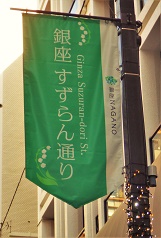
Speaking of Ginza Suzuran Street, it is a vertical street from Ginza 5-chome to 7-chome on the west side of Chuo-dori. Compared to the major Chuo-dori, there are not many traffic, but along Harumi-dori St., there is a gate with a large word "SUZURAN ST", which has a presence.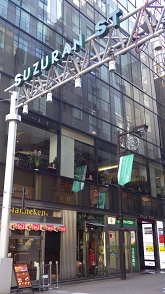
Furthermore, as you can see in the article "MMM ~ Feel the European Wind in Ginza (/archive/2015/12/mm.html)" dated December 30, it is also a street lined with wonderful shops. 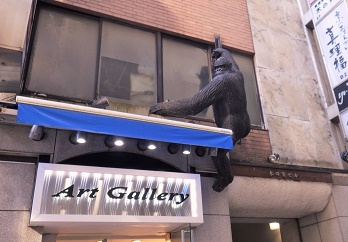 [Ginza Tree Fruit Building on Ginza Suzuran Street] ⇒What is this? 。 。 gorilla is climbing the wall! [Ginza Tree Fruit Building on Ginza Suzuran Street] ⇒What is this? 。 。 gorilla is climbing the wall!
By the way, it is such Ginza Suzuran Street, but in fact, the name of the road changes depending on the location (south and south) in the same Ginza. From 4-chome across Harumi-dori St., the north is Ginza Gas Lantern Street, and the 8-chome is Konparu Street. 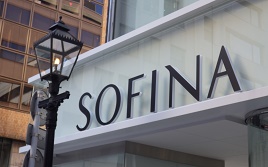 [Restored gas lamps on Gas Lamp Street] [Restored gas lamps on Gas Lamp Street]
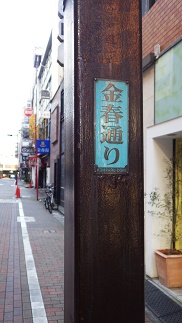 [Kinharu Street] [Kinharu Street]
There are three names on one street and it is not "the first place, the former fish of Hanada ", but "(Suzu) Run (Kinharu) Geisha, Ichi (1, 2-chome) is Akari (= Gas Lamp) It seems that a bad Kawayanagi will be created. However, in fact, Ginza has other "Sideyo-dori" (Azuma ⇒ Shigaraki, brick ⇒ west 5 ⇒ watch), so I want to be careful when introducing shops etc. ", but "(Suzu) Run (Kinharu) Geisha, Ichi (1, 2-chome) is Akari (= Gas Lamp) It seems that a bad Kawayanagi will be created. However, in fact, Ginza has other "Sideyo-dori" (Azuma ⇒ Shigaraki, brick ⇒ west 5 ⇒ watch), so I want to be careful when introducing shops etc. 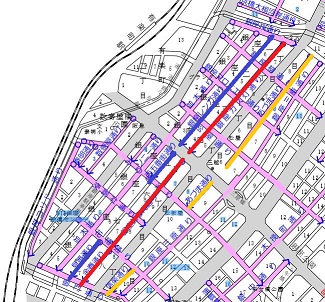 [Ginza Regional Street Map (Chuo-ku Road Section Map was modified)] ⇒1 Azuma ⇒ Shigaraki (yellow), 2 gas lamp ⇒ Suzuran ⇒ Kinharu (red), 3 brick ⇒ west 5 ⇒ watch (blue) [Ginza Regional Street Map (Chuo-ku Road Section Map was modified)] ⇒1 Azuma ⇒ Shigaraki (yellow), 2 gas lamp ⇒ Suzuran ⇒ Kinharu (red), 3 brick ⇒ west 5 ⇒ watch (blue)
By the way, I thought that one case was settled, and "Suzuran Street" had another title. In the article on December 29, "Two MIYUKI DORI (/archive/2015/12/post-2960.html)", we introduced two Miyuki-dori in the city, but there were three "SUZURAN DORI". . ーーIn addition to Ginza, "Suzuran Street" in Hatchobori and "Suzuran Street" in Yagenbori (Higashinihombashi).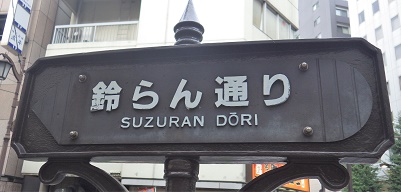
[Suzuran Street in Hatchobori]
Ginza Suzuran Street is also a wonderful street, but "(Hatchobori) Suzuran Street" was also called "Ginza in Shimomachi" before the war, with movie theaters, vaudeville, dance halls, etc. Furthermore, going back to the Edo period, it was a smart area where cool Hatchobori's husband (powerful, concentric) lived. Here, there is an explanation board by the Board of Education of "Hatchobori Yoriki / Concentric Gumishiki Ruins", which is still introduced on the blog on August 18, "Copitiam-in.html) "is an area lined with many attractive shops. 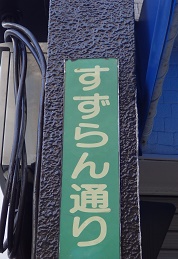 [Suzuran Street in Yagenbori] [Suzuran Street in Yagenbori]
And "(Yagenbori) Suzuran Street", this is a little quiet street compared to Ginza and Hatchobori, but there is teahouse's "Horitsu Chapo", which was founded in 1717 in Kyoho 2 (Kyoho 2), and there is a Tokyo branch of Dai Nippon pyrethrum known for its "Kincho" mark, and this red mark has a considerable impact on this street.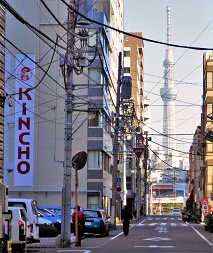
[Yagenbori Suzuran Street]
"Suzuran Street" is very popular because of the familiarity and clean image of the name, and there are quite a few of the same names nationwide. Its origin seems to be Kanda's Suzuran Street, but now it has been formed until the Tokyo Suzuran Street Summit, where eight Suzuran Streets (Akabane, Asagaya, Ogikubo, Kyodo, Ginza, Tachikawa, and Narimasu) gather around Kanda.
Added: Gaslight Street is already complicated just by the explanation so far, but furthermore, the 2-chome part was previously called "Kanze Street". It seems that the name came from the fact that there was Kanze-Yashiki (the residence of Kanzetayu Iemoto of Sarugaku) here during the Edo period, but this area seems to have a similar historical background to Kinharu-dori on 8-chome. In 2004, there was an application for renaming from the local area, and it was renamed Ginza Gas Lantern Street together from 1-chome to 4-chome (Chuo-ku Government Office Road Section Construction Section). 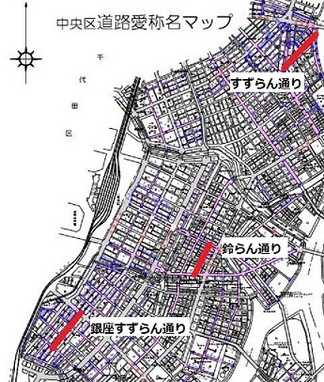 [Three Suzuran Streets in the ward (Chuo-ku Road Section created map was modified)] [Three Suzuran Streets in the ward (Chuo-ku Road Section created map was modified)]
[Ginza Suzuran Street]
Location 5-6 to 7-8 Ginza, Chuo-ku, 104-0061, Japan
[Ginza Gaslight Street]
Location 1-7 to 4-4 Ginza, Chuo-ku, 104-0061, Japan
[Kinharu Street]
Location 8-7 to 8-8 Ginza, Chuo-ku, 104-0061, Japan
[Ginza Tree Fruit Building (Climbing gorilla Wall)]
Location 6-8-6 Ginza, Chuo-ku, 104-0061, Japan
[Suzuran Street]
Location 1-8 to 3-18 Hatchobori, Chuo-ku, 104-0032, Japan
Access Get off at Hatchobori Station on the Hibiya Line or JR Keiyo Line.
[Hatchobori Power / Concentric Gumishiki Site]
Location 3-17-9 Hatchobori, Chuo-ku, 104-0032, Japan (in front of Keika Square)
Access Get off at Hatchobori Station on the Hibiya Line or JR Keiyo Line 30 seconds
[Suzuran Street]
Location 2-4 to 2-19, Higashi Nihonbashi, Chuo-ku, 103-0004, Japan
Access Get off at Higashi Nihonbashi Station on the Toei Asakusa Line
[Nojinya]
January 4, 2016 18:00
New Year 's Day. A friend also receives an invitation 's Day. A friend also receives an invitation  from the New Year' from the New Year' s party along with the New Year's email. This time, I would like to talk about the seasonal topic, "New Year Party"-"Oranda New Year's Day" in the Edo period. s party along with the New Year's email. This time, I would like to talk about the seasonal topic, "New Year Party"-"Oranda New Year's Day" in the Edo period.
At the end of the year, a friend from Iwate Prefecture came to Tokyo and was drinking together in Ginza, saying, "It's almost New Year. Speaking of New Year's Day, it's the New Year's Party together in Ginza, saying, "It's almost New Year. Speaking of New Year's Day, it's the New Year's Party , but I think Gentaku Otsuki, a Dutch scholar from Ichinose (Iwate Prefecture) who was active in the Edo period, learned in history classes, but he also loves the New Year's party , but I think Gentaku Otsuki, a Dutch scholar from Ichinose (Iwate Prefecture) who was active in the Edo period, learned in history classes, but he also loves the New Year's party and knew that he always did it every year? That's also in Ginza. 。 The New Year's party and knew that he always did it every year? That's also in Ginza. 。 The New Year's party in the Edo period became a hot topic. in the Edo period became a hot topic.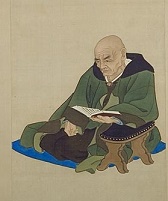
[Gentaku Otsuki statue (Kaisen Oda), Important Cultural Property. Source: Waseda University Library
Gentaku Otsuki (1757-1827) was from the Ichinoseki Domain, and studied Dutch studies in Genpaku Sugita and Ryotaku Maeno, who translated and published "Tarher Anatomia (Dismantling Shinsho)" (1774). He receives one letter from each of them and claims to be Genzawa.
The two masters translated the dismantled new book , and their disciples Sanpaku Inamura, Genzui Udagawa, and Hajime Okada achieved the feat of completing Japan's first Dutch dictionary , and their disciples Sanpaku Inamura, Genzui Udagawa, and Hajime Okada achieved the feat of completing Japan's first Dutch dictionary , "Harma Reconciliation" (1796). However, Genzawa Honjin was rather enthusiastic about the role of backward education , "Harma Reconciliation" (1796). However, Genzawa Honjin was rather enthusiastic about the role of backward education  and producer (how to care?) Perhaps because of this, he wrote the introductory book of Dutch studies (Overview of Dutch studies, Dutch grammar), "Langaku floor (= square) ladder (established in 1788)" and producer (how to care?) Perhaps because of this, he wrote the introductory book of Dutch studies (Overview of Dutch studies, Dutch grammar), "Langaku floor (= square) ladder (established in 1788)" and wrote "Shirando" in Kyobashi as a place to educate his disciples. (1789) is known as the achievement. and wrote "Shirando" in Kyobashi as a place to educate his disciples. (1789) is known as the achievement.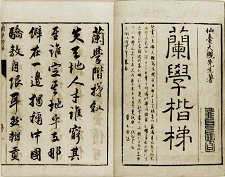
[Langaku Bandai (Source: Kyoto University of Foreign Studies Library)]
At the peak of Genzawa, there were 100 students at the peak, but it was also a gathering of Dutch scholars and a lively discussion. On November 11, 1794, Genzawa held a New Genkai (a party to celebrate the New Year's Day) at Shibarando on November 11, 1794 (old calendar) after a talk in Nagasakiya duringDutch trading post's departure to Edo. A place to deepen fellowship among Dutch scholars and exchange information. In this style, in other words, we planned something like the New Year's party of the West Society, and Genzawa himself bought the secretary himself. 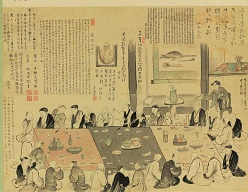 [Shibarando Shingenkai Map (Part) (Gakzan Ichikawa), Important Cultural Property. Source: Waseda University Library) ⇒ Takeyama is also one of Genzawa's disciples, so I think it was probably one of the people who enjoyed participating in this new party. [Shibarando Shingenkai Map (Part) (Gakzan Ichikawa), Important Cultural Property. Source: Waseda University Library) ⇒ Takeyama is also one of Genzawa's disciples, so I think it was probably one of the people who enjoyed participating in this new party.
The 11th of November (old calendar) was January 1 of the Dutch calendar (i.e. the new calendar we are currently using), and we held a banquet to celebrate the New Year of the Netherlands. I think it was a gathering of Dutch scholars who usually study hard, but it seems quite fun. Genzawa used his home as Shibarando, so he relocated every time he moved (there are many in Chuo-ku, such as Kyobashi, Motozaimokucho, Sanjuma Horicho, Minami Konya-cho, Kibiki-cho, Tsukiji-Odawara-cho). However, the first "Oranda New Year" is held around Mizutanicho (currently around Ginza 1-chome). 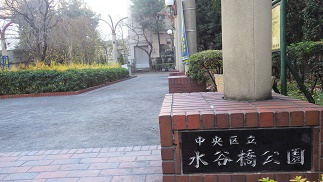 At that time, despite the isolation period, trade with the Netherlands through Dejima in Nagasaki was allowed, and especially during this period, as a result of the reform of Kyoho of the 8th generation Yoshimune Tokugawa, a policy of encouraging practical learning was taken, and since 1720, it seems that there was a background that the import of Chinese translations was partially lifted, and Dutch studies became popular. This event seemed to have been well received, and since then it has been held every year, and after Genzawa's death, his eldest son, Iwasato (Genki), and seems to have continued for 44 years. At that time, despite the isolation period, trade with the Netherlands through Dejima in Nagasaki was allowed, and especially during this period, as a result of the reform of Kyoho of the 8th generation Yoshimune Tokugawa, a policy of encouraging practical learning was taken, and since 1720, it seems that there was a background that the import of Chinese translations was partially lifted, and Dutch studies became popular. This event seemed to have been well received, and since then it has been held every year, and after Genzawa's death, his eldest son, Iwasato (Genki), and seems to have continued for 44 years.
[Shibarando site (estimated)]
Location 12-6 Ginza 1-chome, Chuo-ku, Tokyo 104-0061, Japan (Mizutanibashi Park)
[Nojinya]
January 3, 2016 14:00
In the previous "Heisei no Kurayashiki in Chuo-ku" (/archive / 2015/08/-in-5.html), we introduced regional banks in Chuo-ku. This is the third time in five months since then, but this time I would like in Chuo-ku. This is the third time in five months since then, but this time I would like  to take up the HSBC Group/Hong Kong and Shanghai Banking as a foreign financial institution operating in Chuo-ku. to take up the HSBC Group/Hong Kong and Shanghai Banking as a foreign financial institution operating in Chuo-ku.
From the front of Tokyo Station, walk straight along Yaesu Street and cross Showa-dori, there is the head office of the Bank of East Japan, the second regional bank, which was decided to merge with the Bank of Yokohama in April 2004. Next to the north along Showa-dori, there is a glass-walled building, and at the top it is next to a mark that combines Akachi's hexagon's hexagon with a white butterfly tie -shaped shape, and HSBC's four characters are drawn. This is a glass-walled design similar to the headquarters of Hong Kong, and as you can see from the mark, the Tokyo base of the HSBC Group/Hong Kong and Shanghai Banking. -shaped shape, and HSBC's four characters are drawn. This is a glass-walled design similar to the headquarters of Hong Kong, and as you can see from the mark, the Tokyo base of the HSBC Group/Hong Kong and Shanghai Banking.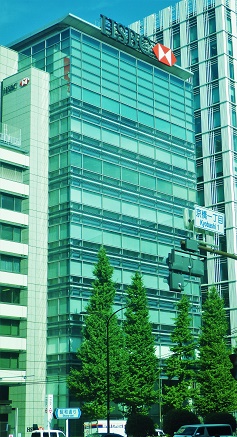
[HSBC Tokyo Branch Building] ⇒It is located near the intersection of Yaesu Street and Showa-dori.
HSBC is a commonly found bank in the city in Hong Kong and other Asian regions, London and Paris, but it is rarely found in Japan.
In 2012, the Premier Banking (services for the wealthy Petit Group), which had been temporarily deployed since 2008, was withdrawn along with private banking. Currently, in Japan, it is limited to commercial financial services (Hong Kong and Shanghai Banking), asset management business (HSBC investment trust), and securities companies (HSBC investment trusts).
However, this bank, in fact, has a very deep connection with Japan. In general, foreign banks (investment banks and commercial banks) in Tokyo are often located around Akasaka and Marunouchi, and among the leading banks based in Chuo-ku, in addition to this HSBC, the Bank of America Merrill Lynch (@Cored Nihonbashi) is located in Hong Kong and Shanghai Banking/HSBC Group.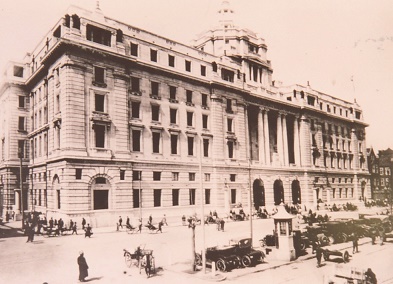
[Shanghai Branch of Hong Kong and Shanghai Banking around 1930] ⇒Currently, it is used as the Sotonada No. 12 building of Shanghai Pudong Development Bank.
Hong Kong and Shanghai Banking was founded in Hong Kong in 1865 by Scotland Thomas Satherland, but Hong Kong and Shanghai Banking first entered Japan in 1866, the year after its establishment. 150 years ago, before the Meiji Restoration, we established our first base in Yokohama, where we had already settled, and opened branches with Kobe (1869), Osaka (1872), and Nagasaki (1896). In response to the Japanese government's policy of wealthy troops since the Meiji era, JBIC loaned £250 million to support Japan's economic growth for the development of infrastructure such as railways, water supply and harbors in Japan.
Following the collapse of the Yokohama branch following the Great Kanto Earthquake of 1923, the Tokyo branch was opened the following year, and after World War II, operations resumed in Tokyo and Kobe after 1947, and continued to support business between Japan and the UK, mainly in the fields of trade finance, etc., in Japan. 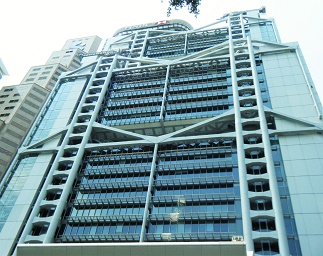 [HSBC Hong Kong Headquarters Building] [HSBC Hong Kong Headquarters Building]
The HSBC headquarters building in Hong Kong is entirely glass-covered and designed to take Feng Shui into account. Here, we also conduct retail banking such as deposits and currency exchange, so you can also visit the inside. The Tokyo branch in Nihonbashi is also a modern glass-walled building (completed in 1998) just like the Hong Kong headquarters, so it is not possible to make deposits here, so there is no chance for internal tours in general.
The former Hong Kong and Shanghai Banking Nagasaki Branch is open to the public as a memorial hall and can be visited inside. This is not glass-covered, but a bank building in the Meiji era, but it's a great pleasure to visit for a tour when traveling to Nagasaki.
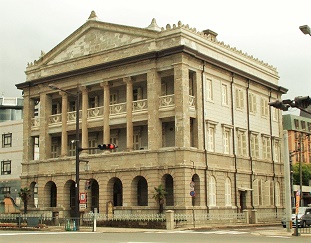
Former Hong Kong and Shanghai Banking Nagasaki Branch Memorial Hall
[Hong Kong and Shanghai Banking Tokyo Branch]
Location 3-11-1 Nihonbashi, Chuo-ku (along Showa-dori)
*As explained in the text, the Tokyo branch does not conduct a retail business and basically does not enter the building. In the case of a tour, let's stop watching from the outside.
[Nojinya]
January 2, 2016 14:00
On the night of December 31st, I went to the nearby Tsukiji Honganji night removal party.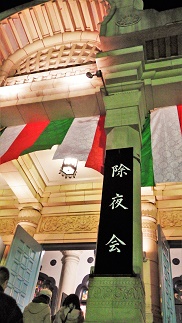
At 22:45, when we arrived in front of the main gate, a bonfire was already lit on the premises, and the ancient Indian style architecture, the main hall (completed in 1934), a national important cultural property, is lit up as bright as daytime. 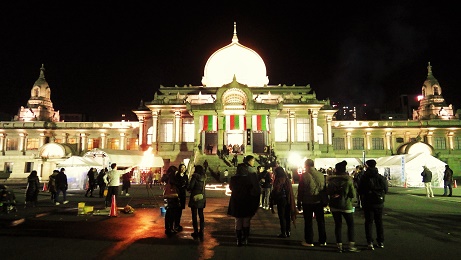 "amazake and Cocoa "amazake and Cocoa  are" are"
How about it! "Would you like to serve hot drinks for free. While warming up in amazake for a while, you will see the lights of candle art and peace depicting the Tsukiji Honganji logo and the letters 2016 PEACE.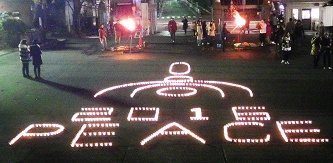
The calm music of the pipe organ that had been flowing until then is over, and Buddhist memorial service by manners begins at 23:00 "Sambutsuge". After the performance of Gagaku and the statement lasted for about 30 minutes, Yugen Yasunaga, chief of the affairs department of Tsukiji Honganji, spoke. Mr. Yasunaga has not always been to the Buddhist gate, but after graduating from university, worked for a city bank for 22 years and launched a management consulting company, and was selected as the chief of the sect of Tsukiji Honganji in July 2015. Person who was done. I was able to listen to easy-to-understand stories based on my experience in the real world.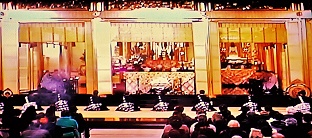
The countdown is over and it is finally 2016. This year's character "Kokorozashi" was shown by Mr. Yasunaga. "I want to make great progress if I notice it by solving small issues one by one while firmly holding" aspirations (= goals) ". 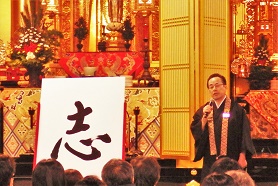 [Tsukiji Honganji] [Tsukiji Honganji]
Location 3-15-1 Tsukiji, Chuo-ku, 104-8435, Japan
Phone: 03-3541-1131
Visiting time in main hall: 6:00 to 17:00 (from April to September to 17:30)
1
|
Links
|
![]() to the ward office after having an errand at the
to the ward office after having an errand at the ![]() end of the New Year's holiday, there is a prize-winning work of the "Chuo-ku Sightseeing Photo
end of the New Year's holiday, there is a prize-winning work of the "Chuo-ku Sightseeing Photo ![]() Contest" on the right side of the lobby on the first floor. As already introduced by the correspondent fireworks of Sumida (/archive/2016/01/post-3012.html), there were many very wonderful works, but behind the exhibition, the sister city of Chuo-ku There is a permanent exhibition about Suzaland.
Contest" on the right side of the lobby on the first floor. As already introduced by the correspondent fireworks of Sumida (/archive/2016/01/post-3012.html), there were many very wonderful works, but behind the exhibition, the sister city of Chuo-ku There is a permanent exhibition about Suzaland.  [Documents related to sister city agreement with Southernland indicated in permanent exhibition on the 1st floor lobby of Chuo-ku government office]
[Documents related to sister city agreement with Southernland indicated in permanent exhibition on the 1st floor lobby of Chuo-ku government office]![]() and Botany Bay. It is known as the birthplace of Australia, where the British naval officer James Cook landed in 1770 when he reached the East Coast of Australia on a voyage around the world. The ward is named by Forbes Sutherland, a Scottish seafarer of the Cook Expedition, who died of tuberculosis during his stay in the area.
and Botany Bay. It is known as the birthplace of Australia, where the British naval officer James Cook landed in 1770 when he reached the East Coast of Australia on a voyage around the world. The ward is named by Forbes Sutherland, a Scottish seafarer of the Cook Expedition, who died of tuberculosis during his stay in the area.
![]() from Japan compared to Europe and the United States, but LCC jetstar Narita flights (Gold Coast, Cairns) have been fully established, and since December 11, ANA has also flew Haneda and Sydney direct flights.
from Japan compared to Europe and the United States, but LCC jetstar Narita flights (Gold Coast, Cairns) have been fully established, and since December 11, ANA has also flew Haneda and Sydney direct flights.
 There are many Australian wine
There are many Australian wine![]() shops in Chuo-ku, but today I will go to "Wineya Ginza 1-chome" near the Chuo-ku Tourism Association. There is a flag of Australia at the entrance of the store, so you can see it right away.
shops in Chuo-ku, but today I will go to "Wineya Ginza 1-chome" near the Chuo-ku Tourism Association. There is a flag of Australia at the entrance of the store, so you can see it right away.![]()
![]()
![]() of New Year's party customers. On the wall, there are objects decorated with wine bottles and explanations of wineries in Australia and New Zealand, so the mood is excited.
of New Year's party customers. On the wall, there are objects decorated with wine bottles and explanations of wineries in Australia and New Zealand, so the mood is excited.
 Mr. Hironaka, a floor staff member, decided to receive red wines from South Australia "Reschke Vitulus Cabernet Sauvignon" and "Mushroom Ahijo".
Mr. Hironaka, a floor staff member, decided to receive red wines from South Australia "Reschke Vitulus Cabernet Sauvignon" and "Mushroom Ahijo".  In this shop, not only Australia wine, but also the snacks are not only classic wine snacks such as cheese and olives, but also the mushroom Ahijo (pictured below) and seafood you received this time, and it has a taste that goes well with wine. In addition, Mr. Hironaka and other clerks are friendly and very pleasant in the Southern Hemisphere.
In this shop, not only Australia wine, but also the snacks are not only classic wine snacks such as cheese and olives, but also the mushroom Ahijo (pictured below) and seafood you received this time, and it has a taste that goes well with wine. In addition, Mr. Hironaka and other clerks are friendly and very pleasant in the Southern Hemisphere.

![]() (Community Cycle) C01 Chuo-ku Government Office Port
(Community Cycle) C01 Chuo-ku Government Office Port

 [Large kite in the Harumi Triton Square Grand Lobby]
[Large kite in the Harumi Triton Square Grand Lobby]


 [Restored gas lamps on Gas Lamp Street]
[Restored gas lamps on Gas Lamp Street]








 At that time, despite the isolation period, trade with the Netherlands through Dejima in Nagasaki was allowed, and especially
At that time, despite the isolation period, trade with the Netherlands through Dejima in Nagasaki was allowed, and especially




 "amazake and Cocoa
"amazake and Cocoa 



